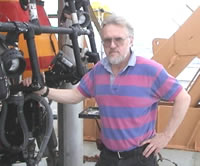|
Participant Perspective - July
31, 2001
 Interview
with Bob Embley Interview
with Bob Embley
Chief Scientist/Marine Geologist - NOAA/PMEL
Jeff
G: What was the biggest surprise for you during NeMO 2001?
Bob:
The biggest surprise was finding that high temperature hydrothermal chimney
in the Coquille vent field. It shows you that we can still miss important
features with the techniques used at present. Imaging and mapping techniques
still aren't there in terms of mapping out an area this size. There are
some limitations using sonar.
Jeff:
What do you see as the future of scientific monitoring at Axial Volcano
and other vent areas?
Bob:
Five years ago we started putting instruments in here. It was partly fortuitous
that the 1998 eruption happened, because we already had instruments in
there at the time. From all our experience out here we figured that this
was going to be the best place to monitor. It's the most active volcanic
area on the ridge. That paid off. When placing the instruments before
the eruption, we talked about having an autonomous system that would help
us understand what was going on during the very first few days after an
eruption or another type of event. We weren't able to get one out here
for the first eruption. The technology is just now getting there. With
the RAS and NeMO Net deployed I think this is the first time that anyone
has a monitoring system that actually has the potential of taking samples
during an eruption on the seafloor. This is an important step and we'd
like to see more instruments being plugged into that system that would
monitor in real-time. This would include seafloor pressure sensors to
monitor inflation of the volcano and changes in the magma supply underneath.
It would give us some clues about when it might erupt and what effects
it would have on the chemistry and biology of the system. Eventually we'd
like to have something that would allow us to do more synoptic surveys
of the whole volcano and take samples periodically where there are events.
The only technology to do this is with an autonomous underwater vehicle
(AUV). AUV's are really coming into their own now. Industry is putting
a lot of money into it. I think we'll have vehicles that will be able
to do the job in a couple years. That's the next step in being able to
continuously monitor the volcano. It's a really important one.
Jeff:
NeMO has a big outreach program. Is this going to continue in the future?
Bob: I think
perhaps NeMO will be expanded to other sites and outreach will be an important
part of it. The ability to send real-time images back, both of the ship
and of the seafloor, is very useful. As technology improves we'll be able
to interact more with people on the shore for educational and outreach
programs. The public is interested in seeing the ocean but there's very
limited access to it by the public. It's just the nature of being able
to transmit images from below the surface. The technology is very expensive
at this point but I think there will be more opportunities in the future.
Publicists at NOAA have a big commitment to this, so it's going to be
an important part of any big program.
Jeff:
You've been on various cruises since early June. Are you ready to go home?
Bob:
Yes, I think so. We have to spend a lot of time onshore trying to analyze
and publish results. You acquire a lot of information during fieldwork.
It takes a long time to analyze and publish it. You get 50 to 100 times
more data now on a given cruise than you did 10 or 20 years ago. So, it's
changed a lot. I'm ready to go home but I also realize that there's a
lot of work ahead from the data that we have in hand and the data from
past years. This year we're going to put a lot of the historical and current
data together. We've got a big meeting next year in Honolulu where we'll
have a lot of technical talks. There's a lot of work left to be done over
the next six months. I'm anxious to start.
|

